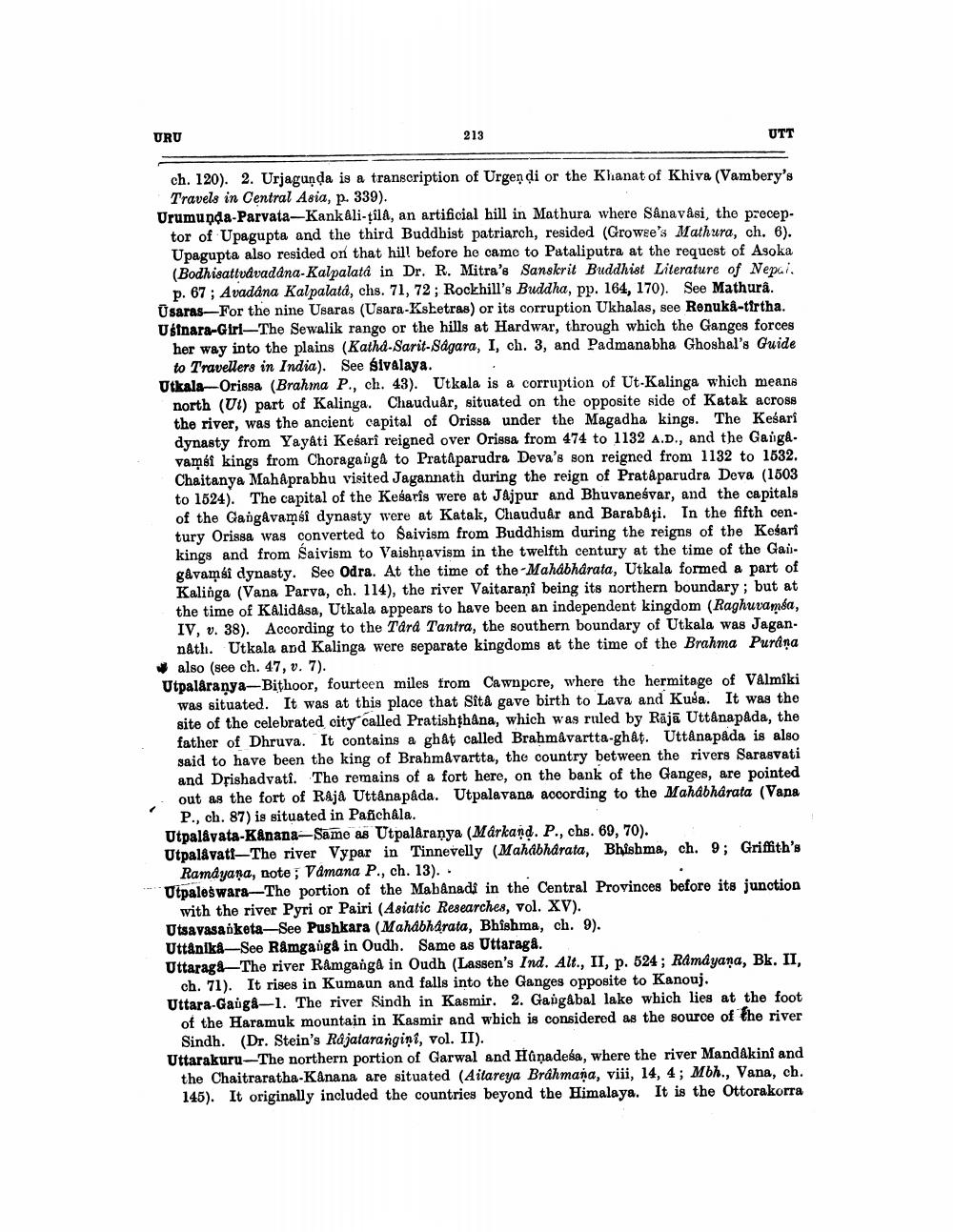________________
URU
213
UTT
ch. 120). 2. Urjagunda is a transcription of Urgen di or the Khanat of Khiva (Vambery's
Travels in Central Asia, p. 339). Urumunda-Parvata-Kankali-tila, an artificial bill in Mathura where Sânavåsi, the precer
tor of Upagupta and the third Buddhist patriarch, resided (Growee's Mathura, ch. 6). Upagupta also resided on that hill before he came to Pataliputra at the request of Asoka (Bodhisattvdvadana-Kalpalata in Dr. R. Mitra's Sanskrit Buddhist Literature of Nepal.
p. 67: Avadana Kalpalata, chs. 71, 72; Rockhill's Buddha, pp. 164, 170). See Mathura. Usaras—For the nine Usaras (Usara-Kshetras) or its corruption Ukhalas, see Renuka-tirtha. Uśfnara-Girl-The Sewalik rango or the hills at Hardwar, through which the Ganges forces
her way into the plains (Katha-Sarit-Sagara, I, ch. 3, and Padmanabha Ghoshal's Guide
to Travellers in India). See sivalaya. . Utkals-Orissa (Brahma P., ch. 43). Utkala is a corruption of Ut-Kalinga which means
north (UI) part of Kalinga. Chauduar, situated on the opposite side of Katak across the river, was the ancient capital of Orissa under the Magadha kings. The Kesari dynasty from Yayati Kesarî reigned over Orissa from 474 to 1132 A.D., and the Ganga. vamsi kings from Choraganga to Prataparudra Deva's son reigned from 1132 to 1532. Chaitanya Mahaprabhu visited Jagannath during the reign of Pratâ parudra Deva (1503 to 1524). The capital of the Kesaris were at Jajpur and Bhuvanesvar, and the capitals of the Gangavamsi dynasty were at Katak, Chauduar and Barabați. In the fifth cen. tury Orissa was converted to Saivism from Buddhism during the reigns of the Kesari kings and from Saivism to Vaishnavism in the twelfth century at the time of the Gaugâvamsi dynasty. See Odra. At the time of the Mahabharata, Utkala formed a part of Kalinga (Vana Parva, ch. 114), the river Vaitarani being its northern boundary; but at the time of Kalidasa, Utkala appears to have been an independent kingdom (Raghuvamsa, IV. v. 38). According to the Tard Tantra, the southern boundary of Utkala was Jagan. nath. Utkala and Kalinga were separate kingdoms at the time of the Brahma Purana
also (see ch. 47, v. 7). Utpalaraṇya-Bithoor, fourteen miles from Cawnpcre, where the hermitage of Valmiki
was situated. It was at this place that Sit& gave birth to Lava and Kuba. It was the site of the celebrated city called Pratishthana, which was ruled by Räjā Uttanapada, the father of Dhruva. It contains a ghat called Brahmâvartta-ghat. Uttanapada is also said to have been the king of Brahmavartta, the country between the rivers Sarasvati and Dfishadvati. The remains of a fort here, on the bank of the Ganges, are pointed out as the fort of Raja Uttanapada. Utpalavana according to the Mahabharata (Vana
P., ch. 87) is situated in Pafchala. Utpalâyata-Kanana--Same as Utpalaranya (Markand. P., chs. 60, 70). Utpalâvati-The river Vypar in Tinnevelly (Mahabharata, Bhishma, ch. 9; Griffith's
Ramdyaņa, note; Vamana P., ch. 13).. Utpaleswara--The portion of the Mahanadi in the Central Provinces before its junction
with the river Pyri or Pairi (Asiatic Researches, vol. XV). Utsavasanketa-See Pushkara (Mahabharata, Bhishma, ch. 9). Uttånika-See Ramganga in Oudh. Same as Uttaraga. Uttarag & -The river Ramganga in Oudh (Lassen's Ind. Alt., II, p. 524; Ramayana, Bk. II,
ch. 71). It rises in Kumaun and falls into the Ganges opposite to Kanouj. Uttara-Gaŭgå-1. The river Sindh in Kasmir. 2. Gangabal lake which lies at the foot
of the Haramuk mountain in Kasmir and which is considered as the source of the river
Sindh. (Dr. Stein's Råjatarangini, vol. II). Uttarakuru-The northern portion of Garwal and Hanadeśa, where the river Mandakini and
the Chaitraratha-Kanana are situated (Aitareya Brahmana, viii, 14, 4; Mbh., Vana, ch. 145). It originally included the countries beyond the Himalaya. It is the Ottorakorra




